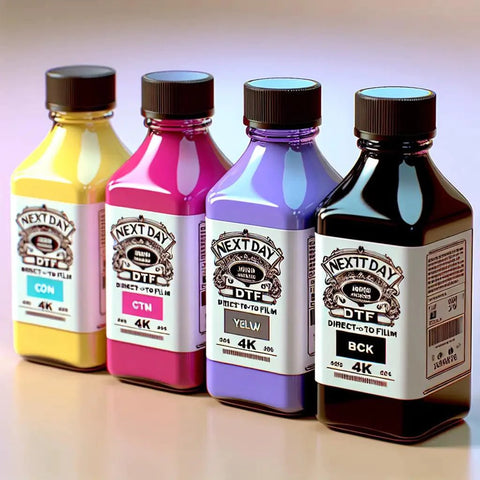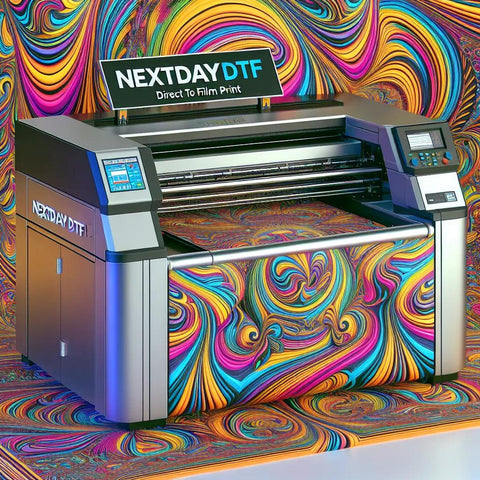-
Introduction to DTF Transfer Printing
- Brief overview
- Growing popularity in the textile industry
-
Understanding Color Management
- Importance in DTF transfer printing
- Role of accurate color representation
-
Key Components of Color Management in DTF
- Color profiles
- Color calibration
- Printer settings
-
Choosing the Right Color Mode
- RGB vs. CMYK
- Impact on print quality
-
Software Tools for Color Management
- Overview of popular tools
- How they enhance color accuracy
-
Calibrating DTF Printers for Optimal Results
- Step-by-step calibration process
- Common challenges and solutions
-
Color Matching in DTF Printing
- Ensuring consistency across prints
- Dealing with color variations
-
Troubleshooting Color Issues
- Identifying common problems
- Practical solutions for better outcomes
-
Tips for Effective Color Management
- Best practices for DTF printing
- Maximizing color vibrancy and accuracy
-
Future Trends in DTF Color Management
- Technological advancements
- Potential improvements in the process
-
Benefits of Accurate Color Management
- Enhanced print quality
- Increased customer satisfaction
-
Challenges in Color Management for DTF Printing
- Industry-specific challenges
- Overcoming hurdles for successful prints
-
Case Studies: Successful Color Management Implementation
- Real-world examples
- Lessons learned from successful implementations
-
Educational Resources for DTF Color Management
- Online courses
- Workshops and seminars
-
Conclusion
- Summarize the importance of color management in DTF printing
- Emphasize its impact on print quality and customer satisfaction
Color Management in DTF Transfer Printing
Color management plays a pivotal role in the world of DTF transfer printing, a technique gaining widespread acclaim in the textile industry. As businesses strive for impeccable prints and vibrant designs, understanding and implementing effective color management techniques become essential.
Introduction to DTF Transfer Printing
DTF transfer printing, or Direct-to-Film transfer printing, has emerged as a game-changer in the textile printing industry. The process involves creating vibrant and detailed prints by transferring designs directly onto a film, which is then heat-transferred onto the fabric. This method has gained popularity due to its versatility and ability to produce high-quality, long-lasting prints on various textiles.
Understanding Color Management
In the realm of DTF transfer printing, color management holds a significant position. It refers to the process of controlling and maintaining consistent colors throughout the entire printing workflow. The accurate representation of colors is crucial in achieving the desired output, ensuring that the final prints match the intended design.
Key Components of Color Management in DTF
For successful color management in DTF printing, several components come into play. Color profiles, calibration, and printer settings are key factors that contribute to the overall accuracy of colors. Creating and utilizing appropriate color profiles for specific materials and ensuring regular calibration of printing equipment are essential steps in achieving optimal results.
Choosing the Right Color Mode
The choice between RGB (Red, Green, Blue) and CMYK (Cyan, Magenta, Yellow, Black) color modes significantly impacts the quality of DTF prints. Understanding the strengths and limitations of each color mode is crucial in achieving the desired color accuracy. While RGB is suitable for vibrant digital displays, CMYK is the standard for traditional printing and often preferred for DTF transfers.
Software Tools for Color Management
Several software tools cater specifically to color management in DTF printing. These tools play a vital role in enhancing color accuracy, providing features for creating and applying color profiles, adjusting printer settings, and ensuring consistent output. Popular choices include [List of Software Tools].
Calibrating DTF Printers for Optimal Results
Calibrating DTF printers is a meticulous process that involves adjusting the printer settings to achieve accurate colors. This step-by-step calibration process ensures that the printer interprets and reproduces colors as intended. Common challenges such as color shifts and inconsistent prints can be addressed through proper calibration.
Color Matching in DTF Printing
Achieving consistency in color matching is paramount in DTF printing. Businesses often face challenges related to color variations across prints. Implementing effective color matching techniques helps in minimizing discrepancies and ensuring uniformity in the final output.
Troubleshooting Color Issues
Despite meticulous planning, color issues may arise during DTF printing. Identifying common problems, such as color banding or inaccurate color reproduction, is crucial. Practical solutions, including adjusting color profiles or troubleshooting printer settings, can address these issues and improve overall print quality.
Tips for Effective Color Management
To maximize the benefits of color management in DTF printing, adopting best practices is essential. Proper maintenance of equipment, using high-quality materials, and staying updated on the latest color management techniques contribute to achieving vibrant and accurate prints.
Future Trends in DTF Color Management
As technology continues to advance, the future of color management in DTF printing holds exciting possibilities. Innovations in color sensing and calibration technologies may lead to even more precise and efficient color reproduction, opening new avenues for the textile industry.
Benefits of Accurate Color Management
The impact of accurate color management extends beyond aesthetics. Businesses that prioritize color accuracy experience enhanced print quality, leading to increased customer satisfaction. Consistency in color reproduction also establishes credibility and reliability in the market.
Challenges in Color Management for DTF Printing
While the benefits are substantial, color management in DTF printing comes with its set of challenges. Industry-specific hurdles, such as compatibility issues with different materials and variations in environmental conditions, require careful consideration for successful color management implementation.
Case Studies: Successful Color Management Implementation
Real-world examples demonstrate the positive outcomes of effective color management. Case studies showcasing businesses that have overcome color-related challenges and achieved superior print quality serve as valuable lessons for others in the industry.
Educational Resources for DTF Color Management
Staying informed about the latest developments in color management is crucial for businesses in the DTF printing sector. Online courses, workshops, and seminars offer educational resources to help individuals and businesses sharpen their skills and stay ahead in the dynamic world of color management.
Conclusion
In conclusion, color management is the backbone of successful DTF transfer printing. By understanding the nuances of color profiles, calibration, and printer settings, businesses can achieve consistent and vibrant prints, ultimately elevating the quality of their products. As the industry evolves, embracing future trends and overcoming challenges will be key to staying at the forefront of DTF color management.
Frequently Asked Questions (FAQs)
-
What is DTF transfer printing?
- DTF transfer printing is a technique where designs are transferred directly onto a film and then heat-transferred onto fabric, popular in the textile industry.
-
Why is color management important in DTF printing?
- Color management ensures consistent and accurate color reproduction, leading to high-quality prints and increased customer satisfaction.
-
How does calibration impact DTF print quality?
- Calibration adjusts printer settings for accurate color reproduction, addressing common issues like color shifts and inconsistencies.
-
RGB or CMYK: Which color mode is better for DTF printing?
- The choice depends on the desired outcome, with RGB suitable for digital displays and CMYK often preferred for traditional printing and DTF transfers.
-
What are some common challenges in DTF color management?
- Challenges include color variations, compatibility issues with materials, and environmental factors affecting color reproduction.
-
Can software tools improve color accuracy in DTF printing?
- Yes, specialized software tools play a crucial role in enhancing color accuracy by creating and applying color profiles and adjusting printer settings.
-
How can businesses troubleshoot color issues in DTF printing?
- Identifying common problems and implementing practical solutions, such as adjusting color profiles, helps troubleshoot color issues.
-
What are the benefits of accurate color management in DTF printing?
- Accurate color management leads to enhanced print quality, increased customer satisfaction, and establishes credibility in the market.





Comments (0)
There are no comments for this article. Be the first one to leave a message!